What is a dry toilet: operating principle and specifics of using autonomous plumbing
The lack of central sewerage is not a reason to give up comfort anywhere.Whether it’s a summer cottage, a construction site or a picnic in a place remote from the amenities of civilization, a mobile, compact and hygienic dry closet will become an indispensable attribute.
What is a dry toilet, on what principle does it work, how to use it, you will find all these details in the article.
The content of the article:
Existing types of dry toilets
A classic dry toilet is a sanitary design based on the natural decomposition of waste. The process is accelerated through the use of biological, natural components. There is also artificial drying and ventilation, which is implemented using electrical appliances.
It is compact and does not contradict all sanitary standards. The main advantage is that you can use this plumbing fixture anywhere because... there is no need to connect it to the sewer.
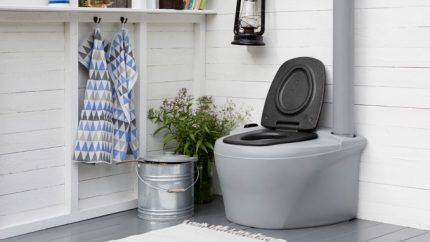
To process waste in dry closets, chemical solutions and natural mixtures are used, based on the following products:
- Peat. This component absorbs all liquid and processes waste products through mineralization.
- Compost. It works in a dry closet tank as well as in a compost pit.
- Sawdust. They are practically never used in their pure form. If they are used, it is only in combination with peat.
- Powder mixtures. These are loose, fine-grained preparations that absorb liquid well and provoke the process of complete waste recycling. They are produced specifically for dry closets.
- Microflora. It is a liquid containing bacteria that utilize waste.
- Bioenzymes. Liquids, the basis of which is a mixture of enzyme proteins and bacteria that decompose organic waste.
Dry toilets vary in design, but they have one thing in common - two containers. One of them is a toilet, and the second collects waste and processes it here. Knowing how to use a home dry toilet, you can significantly improve the quality of your stay both in a house outside the city and in a city apartment.
There are two large groups of these devices: mobile And stationary. The first is a design with small dimensions. There are no difficulties with it either during transportation or installation. With such a device you can go to the dacha, on a picnic, or on a long car trip.
The second group is bio-toilets-cabins. They are equipped with a replaceable container. When it is full, it is replaced with another.
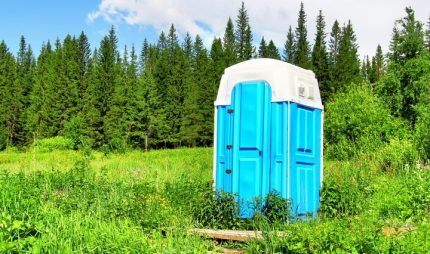
Visually, all models are ordinary toilets, but their operating principles are different.
On this basis they are divided into two types:
- Composting. These include peat and liquid-free models. In the first case, the liquid is not removed, but participates in the processing process. The second type includes all electric autonomous toilets, in which waste is processed into compost as a result of removing liquid from the mass, drying and pressing.
- Liquid. They are chemical and biological. The first storage containers are filled with a product based on formaldehyde, so the result of processing cannot be used as compost. A substance containing bacteria and bioenzymes is poured into the tanks of biological models. What is formed in the tank after their work goes into compost.
At choosing a dry closet focus on the appropriate processing method, the possibility of recycling or waste accumulation, the type of liquid or mixture, model and cost.
Peat toilet specifics
A dry toilet of this type is also called peat or Finnish. If you choose a plumbing device based on its operating principle, this dry toilet is the simplest. It fully corresponds to the name “dry toilet”, because... Only natural ingredients are involved in waste processing.
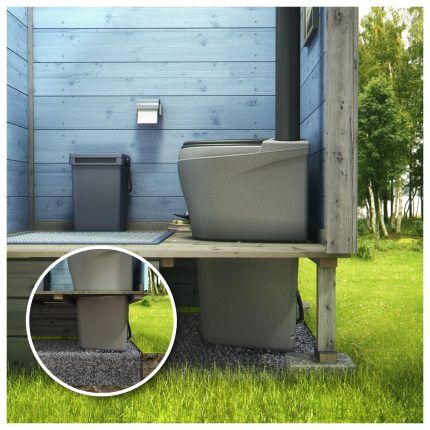
With this method of disposal, liquid is not needed. Waste is adsorbed by peat.
Features of the device and installation
In some cases, the Finnish dry closet is supplemented with an exhaust pipe, which is led out into a special hole or through a window. It must be in a vertical position, with a height of at least 2 m.If there is a cesspool or compost pit nearby, you can build a hose into the lower part to remove liquid waste.
Place the hose in a trench no less than 1.5 m deep, which will protect against freezing of the liquid in winter. This improvement will reduce filler consumption and increase the intervals between removal of contents.
How to operate a peat dry closet?
The operation of a composting toilet is based on the division of waste accumulating in the tank into separate components: solid, liquid and their further breakdown. Outwardly, it resembles a classic toilet, but instead of water in the tank there is peat or other adsorbent. After each use, the filler must be added.
To allow peat to flow into the dry closet container, a dispenser handle is included in the design. After turning it two or three times, the entire contents are covered with peat. This creates a favorable environment for the life of microorganisms that convert waste into useful compost.
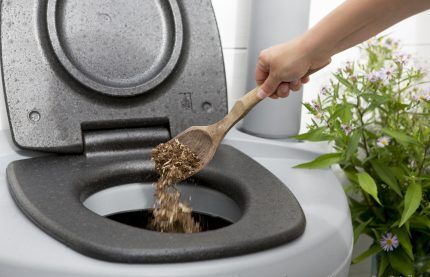
There are designs with an electric dispenser. Then a prerequisite is its connection to the electrical network. The required amount of peat per 10 liters of waste is only 1 kg. To increase its moisture absorption capacity, peat is sometimes combined with sawdust.
The contents of the dry closet will turn into compost, which can be used to fertilize the garden, in two years, and until that time it is kept in a compost pit.
You can read more about how to clean dry toilets in this material.
The best models of peat dry toilets
High quality, aesthetics, versatility and mobility, comfort and aesthetics - this is how most models of peat dry closets can be characterized.
Among them:
- Tandem Compact-M;
- Tandem Compact-Eco;
- Compact Lux M;
- Piteco 506;
- Piteco 905;
- Bioecology Ecolight Summer Resident;
- Kekkila Ecomatic Green.
These are mainly stationary structures. They are compact, made of different materials, and have a different set of components.
#1: Model “Tandem Compact-M”
This model is a stationary design with a 60 liter storage tank. The dimensions of the device are 420 x 580 x 720 mm. The seat is at a height of 380 mm. The weight of this dry closet is 5 kg.
For normal operation it is necessary drainage system and ventilation. For the latter, a ventilation pipe with a cross section of 10 cm is used.
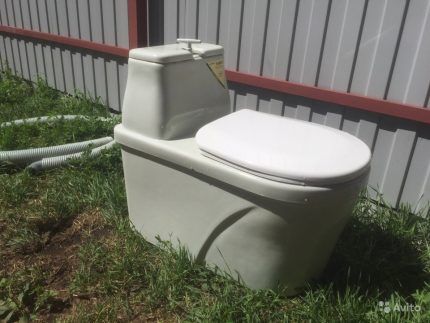
The tank is large enough that waste can be cleaned once a month. It can be installed in a house or in a non-residential extension. There are special handles on the body for moving.
#2: Characteristics of “Tandem Compact-Eco”
This model is the same stationary dry flush toilet, but with a slightly larger storage tank - 70 liters. The polyethylene body design can withstand a maximum load of 180 kg. The height of its seat is 450 mm, dimensions are 520 x 710 x 720 mm.
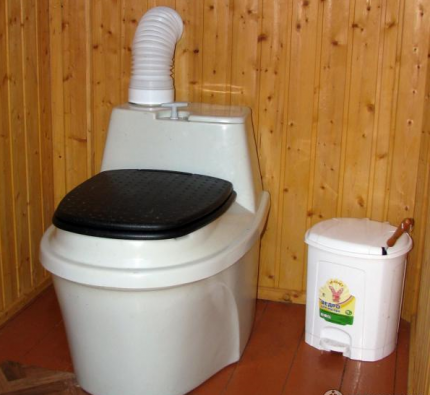
A storage container with a separator is placed inside the base. Both of these parts are made of flexible plastic. A separator separates liquid waste from solid waste. To do this, it has special holes at the bottom and bottom through which liquid leaves and enters the storage part of the structure. The solid part of the waste remains in the separator.
#3: Dry toilet Piteco 506
The design is characterized by small dimensions - 390 x 590 x 710 mm, weighs 20 kg. The seat is at a height of 420 mm. The upper tank has a volume of 11 liters, the storage tank is four times larger - 44 liters. The maximum permissible load is 150 kg.
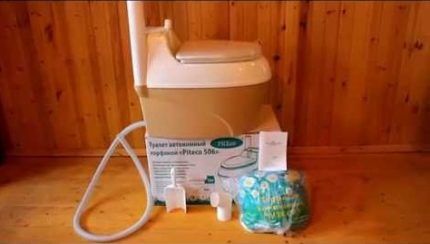
The pipe included in the kit is 3 m long. In addition, the kit contains 3 couplings, a two-meter drainage hose with a clamp and a seat with a lid.
#4: Dry toilet Piteco 905
This dry closet is the most spacious in its line. With rather modest dimensions - 59.5 x 82 x 80 cm, the storage tank holds 120 liters, the upper tank - 30 liters. Toilet height 48 cm, weight - 12 kg.
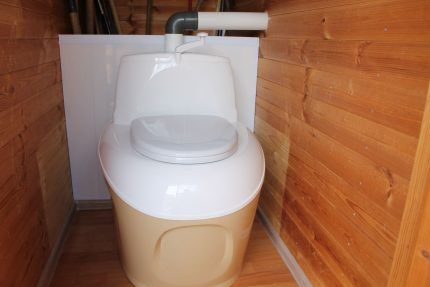
The tank is connected to the drain via a fixed base platform. The outlet after disconnection is closed hermetically by an automatic valve. During waste removal, the ventilation pipe is disconnected from the housing.
#5: Toilet Bioecology Ecolight Summer Resident
Ecolight toilets are produced by the Bioecology company. This is a stationary cabin equipped with a storage tank holding 225 liters. Design dimensions: 1.15 x 2.3 x 1.15 m, weight 60 kg.
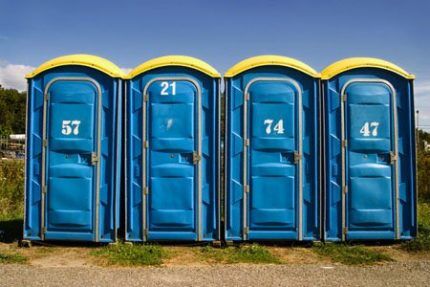
The toilet cabin is made of polyethylene - impact-resistant and fireproof. The set is complemented by an exhaust pipe and a comfortable seat with a lid. There is a special holder for bags inside the cabin.
Unpleasant odors and harmful fumes are neutralized by the ventilation system. Installation and dismantling of the structure is easy, and for its operation there is no need for sewerage, water supply or power supply.
What is a chemical toilet?
This formulation corresponds to a portable outdoor cabin, an indoor mobile toilet, and a block consisting of several cabins where waste is accumulated in receiving tanks. The role of “orderlies” here is played by chemical concentrates based on formaldehyde.
They neutralize odors, prevent the proliferation of various fungi and microbes, and dilute waste. For this reason, the prefix “bio” does not sound entirely correct here.
Considering the features of such a dry closet and how it works, we can come to the conclusion that the waste processed in it cannot be called environmentally friendly. Therefore, composting and using them is not recommended.
Cost-effectiveness is their main advantage - only 5 ml of “chemistry” is needed for 1 liter of waste.
Structurally, these are two containers in contact with each other. The top tank contains water. It is necessary for rinsing. The lower tank is designed for waste recycling.
Odors and liquids do not escape due to the presence of a sealing valve. More advanced models have an indicator. It gives a signal as soon as the tank is full.

Thus, a container with a volume of just over 20 liters must be emptied once every seven days, provided that the toilet is used by a family of three people. This option is very convenient when there is a bedridden patient in the family.
In this case, a toilet of this design can be placed under the bed. At the same time, as the manufacturers assure, there will be no unpleasant odors in the apartment.
Popular models of chemical toilets
Among the most popular chemical dry toilets are the following models:
- Thetford Porta Potti Qube 365;
- Enviro 20;
- Mr. Little Ideal 24;
- Ecostyle Ecogr;
- Bioforce Compact WC 12-20VD.
There are no global design differences between different models. The difference is in the volume of the storage tank and the availability of additional options.
#1: Thetford Porta Potti Qube 365 composting toilet
This portable model is the most popular among chemical toilets. Consumers are attracted by the light weight (4 kg) and compactness (41.4 x 38.3 x 42.7 mm). In this case, the lower tank is designed for 21 liters, and the upper one for 15 liters. The distance from the bottom to the seat is 40.8 cm. According to its parameters, this is the best option when caring for a disabled person.
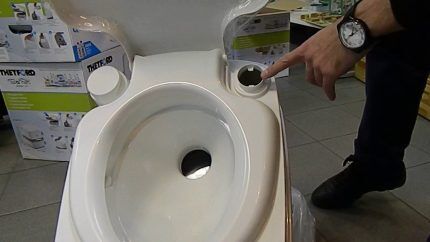
An indicator will indicate the need for maintenance. The lower tank is removable and has handles for carrying.
The negative point is the considerable cost of the drug that breaks down waste.
#2: Enviro 20 chemical toilet
The model is an economical option. It is produced in Canada and can be a good solution for traveling and caring for the disabled.The volume of the upper container is 10 l, the lower one is 20 l. Using latches, the tanks are fixed motionless in relation to each other.
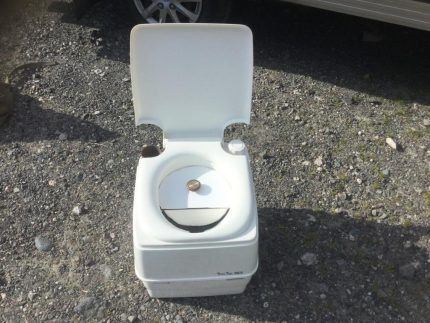
Structurally, the sanitary system is designed so that the storage tank is easily emptied. Filling the flush tank is also no problem. There is also a filling indicator.
#3: Toilet Mr. Little Ideal 24
"Mr. Little" is designed for a large family - 4 - 7 people. Its dimensions are 42 x 41 x37 cm. The reservoir holds 15 liters of water for flushing. The waste container can be filled up to a volume of 24 liters. There are indicators on the receiving tank and water tank.
A piston pump is built into the flushing system. The sanitary device operates in a temperature range from +1 to + 40 degrees.
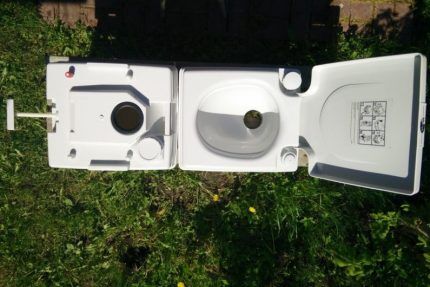
A special liquid is poured into the reservoir, which is located below. Waste breakdown continues for 10 days. A special handle on the storage tank, as well as a built-in removable pipe, simplify the disposal process. In addition, there is an air bleed valve on the housing.
Hidden guides and additional fasteners give this model additional stability. The plastic from which the structure is made does not absorb odors.
#4: Model Ecostyle Ecogr
Chemical toilet Ecostyle Ecogr is a UV-resistant polyethylene toilet cabin. The kit includes a front panel - a door and an arch made of a steel frame.The structure is secured with high-strength hinges on steel rivets. Inside there is a latch equipped with a busy indicator and a hook for things.
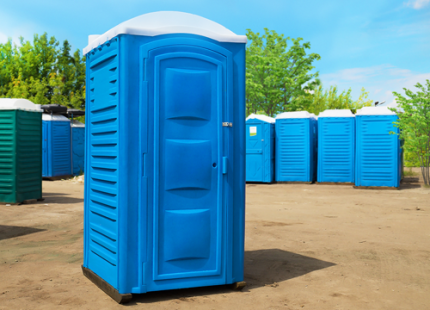
This dry closet weighs 80 kg. The receiving tank is spacious - 250 l. In the cabin there is a wooden pallet impregnated with a moisture-repellent substance. Cabin dimensions - 1.1 x 2.2 x 1.1 m.
#5: Portable model Bioforce Compact WC 12-20VD
The design is assembled from two compartments: upper - 12 l and lower - 20 l. The first is filled with the flushing inlet. It is complemented by a pump and a seat with a lid. The lower compartment collects waste.
There is a sliding valve that does not allow odors and liquids to pass through. Excess pressure is released via a release valve. The waste level is monitored by an indicator.
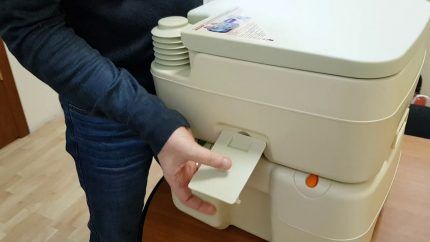
The model is designed for a maximum load of 120 kg. It has dimensions of 370 x 435 x 420 mm. The lower tank is removable
These chemical toilets are produced in Thailand. Their installation does not require additional ventilation or communications.
Features of an electric dry closet
This design is significantly different from the first two. The liquid from the electric toilet is discharged into a cesspool or into the sewer. Solid residues are sprinkled with disinfectant powder and dried or burned.
In any case, waste takes up a very small volume. They can then be used as fertilizer. Among autonomous toilets, this design is the most expensive and requires constant power supply and forced ventilation.
Without this, it will not be possible to avoid the odors that appear when burning or drying solid residues. Therefore, ventilation is a must.
#1: Electric dry closet Cinderella
The plumbing fixture is produced in Norway. It is considered waste-free. There is no need to connect water to it. The flushing process is carried out using a compressor connected to the mains.
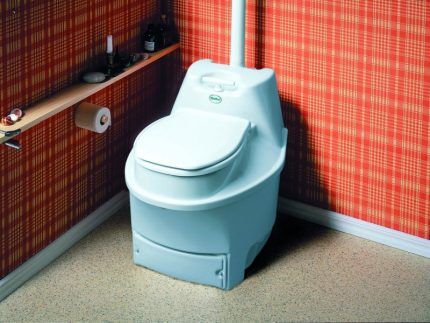
Waste incineration is carried out in a special container. After this, only 100% safe ash remains, from which the toilet is emptied twice a month. This dry closet operates from a 220 V network. Ventilation is installed through the roof or through the wall.
#2: Electric dry toilet Separett Villa 9011
This electric dry closet was produced in Sweden. Its distinctive feature is that it can even be connected to a car battery. The model operates without water connection. The liquid component of the waste leaves through a flexible hose, and the solid component in a 23-liter tank is dried and reduced in volume by up to 70%.
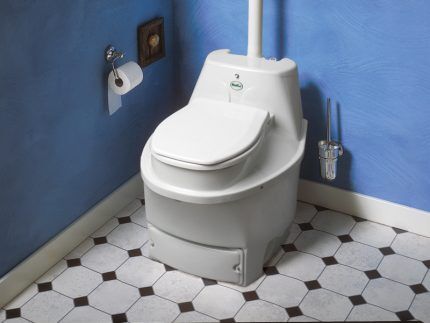
For the fan to work, it is connected to a voltage of 220 V. The kit also includes a seat for children. The only negative is the mandatory ventilation device.
For some, the inconvenience is the fact that the device can only be used in a sitting position. This is explained by the fact that the back of the container in which waste is collected opens only under the weight of a person.
#3: BioLet 25 dry toilet
This stationary electric toilet with an ABS plastic body is made in Sweden and is designed for 3 people.Equipped with a fan and automatic compost mixing function. Dimensions of the plumbing fixture - 550 x 650 x 710 mm. Height from base to seat - 508 mm.
The power consumption of the plumbing system is 20 - 5 W. The kit includes the toilet itself, pipes, and a catalyst. An exhaust system is required for proper operation.
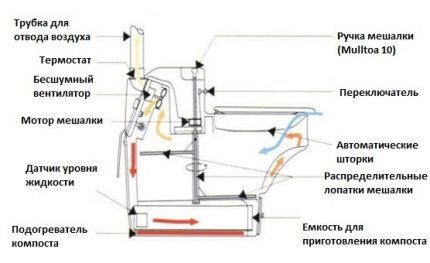
During mixing, some of the dry processed product spills into the tray through the grate. The compost mass is blown by a fan. Vapors and odors escape through the ventilation system. If liquid accumulates above normal, the float switch automatically activates the air blower.
The thermostat can also be used to manually adjust the liquid level by adding or lowering degrees inside.
Recommendations for future dry toilet buyers
When choosing a suitable dry closet, you should be guided by several criteria:
- Simplicity of design and convenient operation.
- Hygiene, ability to retain unpleasant odors.
- Stability, strength, high-quality assembly.
- Ease of maintenance.
- Volume of the tank. It must correspond to the number of residents.
- Seat height. The optimal size is 400–460 mm, but the presence of children must also be taken into account.
- The presence of a seat heating function and a tank full indicator.
For use in a country house, it is advisable to purchase a portable plumbing system. In summer she can be outside, in winter - in the house.
It is better if the selected dry toilet does not use chemicals.Then the processed waste can be used as fertilizer.
If the model is electric, then where it is to be used there should be no problems with power supply.
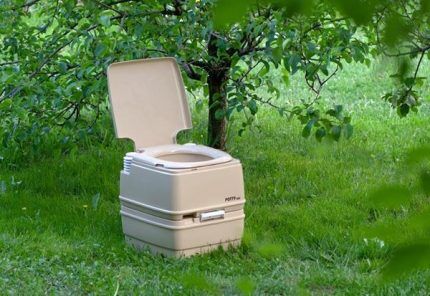
For an apartment, a stationary option with a good design is better. If finances allow, you can install an electric model with many functions. You also need to calculate the volume of the container; the frequency of its emptying depends on this.
If you don’t have enough money to buy a dry closet, you can build it yourself. You can read how to do this in this material.
Conclusions and useful video on the topic
Correct use of a dry closet:

Choosing the optimal dry closet option:

In places where the benefits of civilization have not yet reached, perhaps there is no more convenient design for the disposal of waste than a dry closet. It is also a worthy way out of a situation when there is a bedridden patient in the house.
The main thing is to choose a device that is suitable for specific circumstances and meets all requirements both in terms of quality and functionality.
Do you have a dry closet at your dacha? Please tell us which model you chose, what guided your decision, and whether you are satisfied with your purchase. Write your comments in the block below the article.




We installed a composting toilet in our country house a long time ago because it is easier to care for than a simple summer toilet, and it looks much better. This type of autonomous plumbing is more convenient and comfortable to use. However, it can also be used in winter, unlike summer outdoor ones, which are very cold in winter.I believe that a dry toilet is the best option for a summer cottage until a permanent one is installed in the house.
In the summer, our dry toilet is in a box that was built for an outdoor toilet, and in the autumn-winter we bring it into the house into a combined bathroom, in which the pipes have not yet been connected to a stationary toilet. There is almost no smell from the dry closet, but we use peat. In the city, I can’t go to plastic dry toilets because of the terrible smell and appearance. The dry closet for our dacha is a temporary phenomenon.
Do you have a dry closet with drainage? Which brand? It’s just that we also use peat at our dacha, but the smell from it is quite noticeable. And often, not only the smell of rotten grass.
If you are not happy with the smells from your peat toilet, then I can recommend an alternative inexpensive solution. This is a Thetford Porta Potti 165, costing about $80. The dry closet consists of two parts, upper and lower.
For each of the parts you need to fill a separate liquid: blue in the bottom, pink in the top. For 100 ml of chemicals you will need 3 liters of water, refill through a special technical hole. This toilet can be used even in the house, there is no smell from it.
If you buy original chemicals from the manufacturer Thetford, it will be quite expensive: about $40 for two bottles. As an alternative, I can offer a set of Master WC Rinse 1 l + Blue 1 l liquid for only 6 dollars. There is practically no difference in the principle and quality of action.